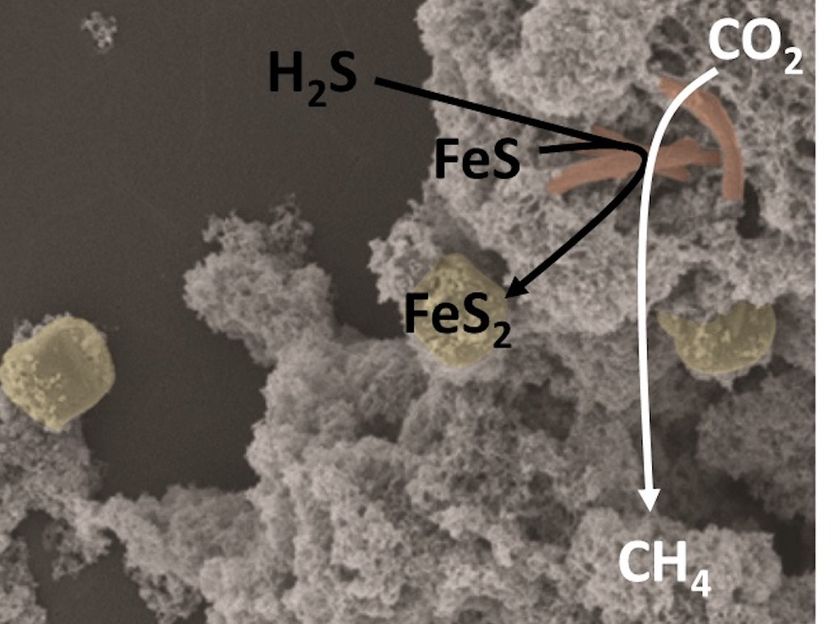Discovery of a Primordial Metabolism in Microbes
microorganisms are well known to grow at the expense of almost any chemical reaction if it can deliver a small fraction of the cell internal “energy currency “ATP. Now, a team of German environmental microbiologists from the Leibniz Institute DSMZ–German Collection of Microorganisms and Cell Cultures in Brunswick, the University of Konstanz, and the University of Tübingen could show that microorganisms can mediate the conversion of iron sulfide and hydrogen sulfide to pyrite. This reaction was postulated to have operated as an early form of energy metabolism on primordial Earth.
Pyrite, better known as fool’s gold, is the most abundant iron-sulfur mineral in sediments. Over geological times, its burial in sediments controlled oxygen levels in the atmosphere and sulfate concentrations in seawater. The conversion of iron sulfide and hydrogen sulfide to pyrite was also postulated as the energy-delivering process to drive autocatalytic synthesis of organic matter in micro-compartments of marine hydrothermal vents. The latter are currently regarded as the most likely place for life to have emerged on Earth. To date, pyrite formation was considered to be a pure (geo)chemical reaction. The new results presented here show that also microorganisms can mediate pyrite formation at ambient temperature and gain energy for growth from its overall conversion from iron sulfide and hydrogen sulfide. Michael Pester from the Leibniz Institute DSMZ/TU Braunschweig, Joana Thiel and Bernhard Schink from the University of Konstanz in collaboration with James M. Byrne and Andreas Kappler from the University of Tübingen published these results now in the Proceedings of the National Academy of Sciences U.S.A.
Under the exclusion of oxygen, the scientists enriched environmental microorganisms from different sediments and even wastewater treatment plants using iron sulfide, hydrogen sulfide, and carbon dioxide as the only substrates. Here, pyrite formed concomitantly with methane over extended time periods of several months. Pyrite formation showed a clear biological temperature dependence profile and was strictly coupled to parallel methane formation. The presented results provide insights into a metabolic relationship that could sustain part of the deeply buried biosphere in sediments and lend support to the iron-sulfur-world theory that postulated iron sulfide transformation to pyrite as a key energy-delivering reaction for life to emerge.

Electron microscopy image of a pyrite forming culture enriched from a wastewater treatment plant. Microbial cells are highlighted in red and pyrite crystals in yellow.
DSMZ/Prof. Dr. Michael Pester
Original publication
Other news from the department science

Get the life science industry in your inbox
By submitting this form you agree that LUMITOS AG will send you the newsletter(s) selected above by email. Your data will not be passed on to third parties. Your data will be stored and processed in accordance with our data protection regulations. LUMITOS may contact you by email for the purpose of advertising or market and opinion surveys. You can revoke your consent at any time without giving reasons to LUMITOS AG, Ernst-Augustin-Str. 2, 12489 Berlin, Germany or by e-mail at revoke@lumitos.com with effect for the future. In addition, each email contains a link to unsubscribe from the corresponding newsletter.
Most read news
More news from our other portals
Last viewed contents
Category:Molluscicides
Proteins may point to alcohol use test
Brain inflammation targeted in first drug discovery project from £3m Dementia Consortium
Centre_for_Infectious_Disease_Research_in_Zambia_(CIDRZ)
Tiotropium
First open genetic testing accreditation workshop proves a major success - Participants from across Europe welcome initiative

New SARS-CoV-2 variant Eris on the rise - SARS-CoV-2 lineage EG.5.1 has an advantage at evading neutralizing antibodies
Leishman_stain

Research on airway protective reflexes wins 2024 Eppendorf & Science Prize
Hospital_ship



















































